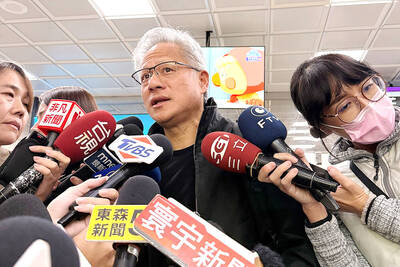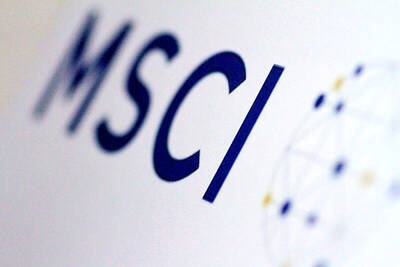Industrial production last month increased 10.41 percent year-on-year, driven by transferred orders and recovering market demand in the manufacturing sector, the Ministry of Economic Affairs’ Department of Statistics said yesterday.
Output from the manufacturing sector, which contributes more than 90 percent of total industrial production, last month grew 11.09 percent year-on-year.
The increase was mainly due to strong growth in the electronic components industry and the computers, electronics and optical components industry, department Deputy Director-General Wang Shu-chuan (王淑娟) told a news conference in Taipei.
“Despite the spread of the coronavirus [COVID-19], the electronic components industry was mostly unaffected, hitting a record high last month, surging 26.04 percent year-on-year thanks to vigorous production of integrated circuit boards,” Wang said, adding that production jumped 40.26 percent on an annual basis as demand for 5G communications and high-performance computing expanded.
Moreover, production of LCDs, which has been falling due to a supply and demand imbalance, showed early signs of recovery, declining 1.1 percent last month, the smallest in 17 consecutive months of drops, she said.
“Local panel makers have received transferred orders amid a production hiatus in China,” Wang said, adding that the withdrawal of some South Korean panel makers also benefited domestic firms.
Samsung Electronics Co has announced its exit from the oversaturated LCD market to focus on better-resolution OLED manufacturing.
The computer, electronics and optical components industry, which has been on a hot streak since the start of last year amid trade tensions between the US and China, last month posted a 22.16 percent annual increase in output on the back of rising demand from China.
As Chinese production of smartphones and other handheld devices seeks to get back on track, Taiwanese manufacturers have received increased orders for optical lenses and components, Wang said.
“The production of servers, routers and network switches has also grown, along with demand for sturdier Internet structures as more people have begun working and studying remotely,” she said.
While the COVID-19 pandemic has bolstered some high-tech industries, it is proving to be much more detrimental for traditional industries.
Output from the base-metal and the machinery equipment industries last month dropped 1.81 percent and 3.32 percent year-on-year respectively as demand dwindled, Wang said.
“It could have been worse... The decline is somewhat offset by demand [from high-tech industries], which commanded necessary materials such as copper foil, aluminum alloy and other equipment used to expand production,” she said.
Output from the chemical materials industry contracted 6.83 percent on an annual basis as state-run oil refiner CPC Corp, Taiwan’s (台灣中油) petrochemical plant in Kaohsiung was still undergoing a routine inspection, Wang said, adding that falling oil prices also weighed on production.
The automobile and auto parts industry posted a slight rise of 2.06 percent in output, propelled by sales of new models, she said.

PERSISTENT RUMORS: Nvidia’s CEO said the firm is not in talks to sell AI chips to China, but he would welcome a change in US policy barring the activity Nvidia Corp CEO Jensen Huang (黃仁勳) said his company is not in discussions to sell its Blackwell artificial intelligence (AI) chips to Chinese firms, waving off speculation it is trying to engineer a return to the world’s largest semiconductor market. Huang, who arrived in Taiwan yesterday ahead of meetings with longtime partner Taiwan Semiconductor Manufacturing Co (TSMC, 台積電), took the opportunity to clarify recent comments about the US-China AI race. The Nvidia head caused a stir in an interview this week with the Financial Times, in which he was quoted as saying “China will win” the AI race. Huang yesterday said

Nissan Motor Co has agreed to sell its global headquarters in Yokohama for ¥97 billion (US$630 million) to a group sponsored by Taiwanese autoparts maker Minth Group (敏實集團), as the struggling automaker seeks to shore up its financial position. The acquisition is led by a special purchase company managed by KJR Management Ltd, a Japanese real-estate unit of private equity giant KKR & Co, people familiar with the matter said. KJR said it would act as asset manager together with Mizuho Real Estate Management Co. Nissan is undergoing a broad cost-cutting campaign by eliminating jobs and shuttering plants as it grapples

The Chinese government has issued guidance requiring new data center projects that have received any state funds to only use domestically made artificial intelligence (AI) chips, two sources familiar with the matter told Reuters. In recent weeks, Chinese regulatory authorities have ordered such data centers that are less than 30 percent complete to remove all installed foreign chips, or cancel plans to purchase them, while projects in a more advanced stage would be decided on a case-by-case basis, the sources said. The move could represent one of China’s most aggressive steps yet to eliminate foreign technology from its critical infrastructure amid a

MORE WEIGHT: The national weighting was raised in one index while holding steady in two others, while several companies rose or fell in prominence MSCI Inc, a global index provider, has raised Taiwan’s weighting in one of its major indices and left the country’s weighting unchanged in two other indices after a regular index review. In a statement released on Thursday, MSCI said it has upgraded Taiwan’s weighting in the MSCI All-Country World Index by 0.02 percentage points to 2.25 percent, while maintaining the weighting in the MSCI Emerging Markets Index, the most closely watched by foreign institutional investors, at 20.46 percent. Additionally, the index provider has left Taiwan’s weighting in the MSCI All-Country Asia ex-Japan Index unchanged at 23.15 percent. The latest index adjustments are to